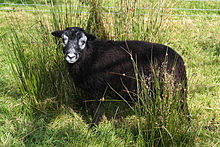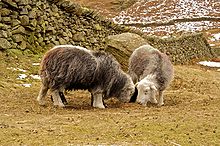Herdwick

The Herdwick is a
The wool of a Herdwick has unique qualities relating to durability. Thick bristle type fibres will often protrude from garments made from the wool, forming a protective layer in blizzards—most likely the same qualities that protect the sheep in similar conditions. Herdwicks have been known to survive under a blanket of snow for three days while eating their own wool.[3]
Severely threatened by the 2001 outbreak of foot-and-mouth disease in England and Wales, the breed has survived due to the intent to preserve this unique animal as a crucial part of traditional Lakeland agriculture. Still far fewer in number than most commercial breeds, Herdwicks survive largely due to farming subsidies.
History
Early history

The
For centuries, the husbandry of Herdwick sheep has been a large factor in shaping the culture and terrain of the Lake District. Topographically, grazing by sheep continues to keep the hillsides of fells largely treeless, and the ubiquitous
Beatrix Potter
In the later years of her life (over 50), the children's author Beatrix Potter was involved with keeping and breeding Herdwicks, even acting as president of the breed association for a time. Between 1930 and 1938 she won a number of prizes for Herdwick ewes at shows across Cumbria.[8] Upon her death in 1943, she bequeathed fifteen farms—a total of approximately 4,000 acres (16 km2) to the National Trust and, as per her instruction, all continue to graze Herdwick flocks.[1]
Modern history

In the modern era, the main industry of the Lake District has shifted from agriculture to tourism. The subsequent influx of tourists to the District has at times conflicted with traditional life, including the raising of Herdwicks. One Lake District farmer summed the problem up as, "We get 100,000 visitors across our land every year... If just one in a thousand forgets to shut a gate or can't be bothered, that's a hundred times we have to go out and round up our sheep."[1]
In the late 20th century, the keeping of Herdwicks became economically unviable without outside support;

Ninety-five percent of all 50,000 or so Herdwicks live within 14 miles of
There are other mountain sheep on the Lakeland fells, notably
Rough-Fells, but the hardy Herdwick is the sheep most likely to be seen in and around the Duddon valley, the Coniston fells, the Buttermere fells and, through Borrowdale or Wasdale, up to the highest land in England, the Scafells. More than the old drystone walls that quarter the fells, the packhorse bridges or the whitewashed farmsteads, the little grey Herdwick sheep typify the Lakeland. If they and their shepherds go, that is the end of the Lakeland where I have climbed, walked, skied and skated for nearly 80 years; of the Lakeland I have written about nearly all my life.[13]
The destruction of entire flocks meant that the shepherds were forced to undergo the process of again heafing (the local term for hefting) their new sheep to the hills. Normally, ewes teach this behaviour to their lambs, but with no more ewes left acquainted with a particular heaf the behaviour had to be taught all over again to new ewes, inevitably involving much rounding up of flocks that had strayed over the often inaccessible fells. Unheafed sheep might also cause overgrazing by wandering if they replaced the original Herdwicks.[1][14] The Cumbria Hill Sheep Initiative was set up to "reassess the position and circumstances" in the aftermath of the disease; tough government restrictions in order to prevent another outbreak are still in place.[15][16]
In 2008, an
Characteristics
Herdwicks are a dual-purpose breed, producing strongly flavoured
A Herdwick's grey fleece is not easily dyed and is coarse, so it is best suited to use as
Herdwick lambs are born black and, after a year, they lighten to a dark brown colour (the sheep are called hoggs or hoggets at this stage). After the first shearing, their fleece lightens further to grey. Rams are horned and ewes polled.[21] For shows and auctions, Herdwicks traditionally have their wool ruddied up (the local term for raddled) with dye. Rams are also ruddied when put out with the ewes to show which have been mated and the dye is also one method (called a smit) of marking sheep for ownership. Before chemical dyes became available, this dye was made from either iron ore or graphite mixed with grease. For many years the legal method of identifying a particular shepherd's sheep were notches cut out of a sheep's ear, called lug marks—now replaced by ear tags.[1]
References
- ^ National Geographic Magazine. 182 (2). National Geographic Society.
- ^ a b c "Introduction to Herdwick Sheep". Herdwick Sheep Breeders Association. Archived from the original on 4 February 2012. Retrieved 31 October 2007.
- ^ Davies, Hunter. A Walk Around the Lakes, Frances Lincoln Limited, 2009 (revised edition), p. 94
- ^ "Herdwick Sheep Breeders Association". Archived from the original on 28 October 2007. Retrieved 31 October 2007.
- ^ Ferguson, Richard Saul (1894). A History of Westmoreland. E. Stock. p. 290.
Herdwick sheep.
- ISBN 978-0-300-08880-9.
- ^ ISBN 1-85828-894-0.
- ISBN 0-7112-2381-5. p. 124
- ^ ISBN 1-85828-894-0. Archived from the originalon 17 October 2007.
- ^ Elliot, Valerie (7 March 2009). "Butchers urged to sell meat from rare British sheep". The Times. London.
- ^ "UK begins mass animal burial". CNN. 26 March 2001. Archived from the original on 29 October 2007. Retrieved 31 October 2007.
- ^ Jones, George (26 March 2001). "Blair puts off use of vaccination in second U-turn". The Daily Telegraph. London. Archived from the original on 19 November 2002. Retrieved 31 October 2007.
- ^ "If they go, it is the end of Lakeland". The Guardian. London. 11 April 2001. Retrieved 2 November 2007.
- ^ "Ark of Taste". Slow Food Foundation for Biodiversity. Retrieved 31 October 2007. [dead link]
- ^ "Herdwick Sheep Breeders' News". Herdwick Sheep Breeders Association. Archived from the original on 5 February 2012. Retrieved 31 October 2007.
- Whitehaven News. Retrieved 31 October 2007. [dead link]
- ^ King, Tim. "Herdwick Sheep: Sturdy & Scrumptious". Sheep! magazine. Retrieved 7 November 2008.
- ^ "Protected status for Lakeland Herdwick sheep". BBC. 16 May 2013.
- ^ Lake District National Park Authority. Archived from the originalon 22 October 2007. Retrieved 1 November 2007.
- ^ "Thermafleece: Sheep's Wool Home Insulation". Retrieved 31 October 2007.
- Oklahoma State University. Retrieved 6 September 2016.
External links
- The Herdwick Sheep Breeders' Association website
- The Sheep Trust—a national charity supporting the Herdwicks and other heritage sheep breeds
- Supporting Hill Farming The National Trust (archived from November 2011)
